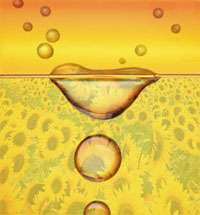Tiny Microreactor For Biodiesel Production
 CORVALLIS, Ore. - Chemical engineering researchers at Oregon State University have developed a tiny chemical reactor for manufacturing biodiesel that is so efficient, fast and portable it could enable farmers to produce a cleaner-burning diesel substitute on their farms using seed crops they grow on their own land.
CORVALLIS, Ore. - Chemical engineering researchers at Oregon State University have developed a tiny chemical reactor for manufacturing biodiesel that is so efficient, fast and portable it could enable farmers to produce a cleaner-burning diesel substitute on their farms using seed crops they grow on their own land."This could be as important an invention as the mouse for your PC," said Goran Jovanovic, the OSU professor who developed the biodiesel microreactor. "If we're successful with this, nobody will ever make biodiesel any other way."
Current biodiesel production methods involve dissolving a catalyst, such as sodium hydroxide, in alcohol, then agitating the alcohol mixture with vegetable oil in large vats for two hours. The liquid then sits for 12 to 24 hours while a slow chemical reaction occurs, creating biodiesel and glycerin, a byproduct that is separated. This glycerin can be used to make soaps, but first the catalyst in it must be neutralized and removed using hydrochloric acid, a tedious and costly process.
The microreactor developed at OSU eliminates the mixing, the standing time for separation and potentially the need for a dissolved catalyst.
But more importantly, Jovanovic says, the microreactor, which is about half the size of a thick credit card, could help farmers reduce their dependence on mass-produced petroleum as well as reduce the need to distribute fuel via truck, tanker or pipeline.
"This is all about producing energy in such a way that it liberates people," Jovanovic said. "Most people think large-scale, central production of energy is cheaper, because we've been raised with that paradigm. But distributed energy production means you can use local resources - farmers can produce all the energy they need from what they grow on their own farms."
The microreactor, being developed in association with the Oregon Nanoscience and Microtechnologies Institute (ONAMI), consists of a series of parallel channels, each smaller than a human hair, through which vegetable oil and alcohol are pumped simultaneously. At such a small scale the chemical reaction that converts the oil into biodiesel is almost instant.
Although the amount of biodiesel produced from a single microreactor is a trickle, the reactors can be connected and stacked in banks to dramatically increase production. "By stacking many of these microreactors in parallel, a device the size of a small suitcase could produce enough biodiesel to power several farms, or produce hundreds of thousands of gallons per year," Jovanovic said.
Using microreactors, biodiesel could be produced between 10 and 100 times faster than traditional methods, said Jovanovic, who is also developing a method for coating the microchannels with a non-toxic metallic catalyst. This would eliminate the need for the chemical catalyst, making the production process even more simple, a key to widespread use.
Jovanovic is looking to partner with a new or existing company in order to commercialize the technology through the Microproducts Breakthrough Institute at ONAMI, Oregon's signature research center focused on growing research and commercialization to accelerate innovation-based economic development in Oregon and the Pacific Northwest.
But he admitted it will take a visionary business partner.
"The challenge is that we're trying to change a paradigm, moving from centrally-produced energy to distributed energy production, and that's not easy," he said. "But wind and solar energy technologies faced difficulties in their early days. And we're coming to a place in history where we cannot tolerate the growing uncertainty of petroleum-based energy supplies."
ONAMI is a collaboration involving Oregon's three public research universities - Oregon State University, Portland State University and University of Oregon - as well as the Pacific Northwest National Laboratory in Richland, Wash., the state of Oregon and the regional business community.
President Bush, in his 2006 State-of-the-Union address, pledged support for cutting-edge research in methods to produce biofuels. Jovanovic hopes his research will get a benefit from this pledge.
The federal government has granted $8 million over four years to OSU as one of the country's five Sun Grant centers of excellence - regional hubs charged with research and development of new technologies for using agricultural wastes, residues and new crops for the production of bio-energy.


0 Comments:
Post a Comment
<< Home